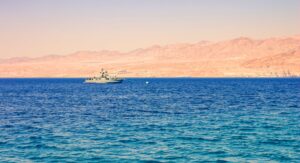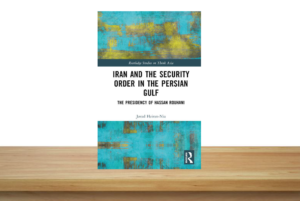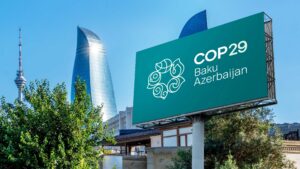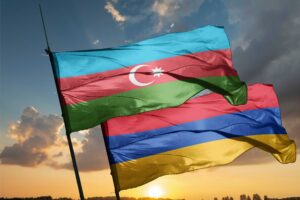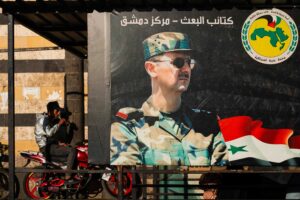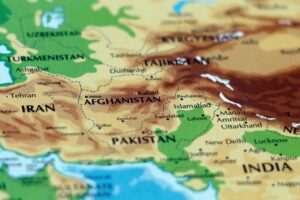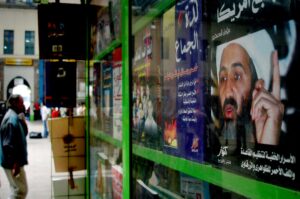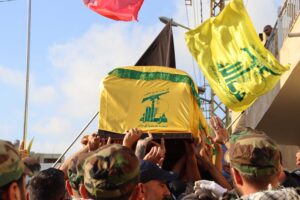Introduction
Since the 1979 Iranian Revolution, political power in Iran has been held in a balance between the revolutionaries, which became the Islamic establishment, and elected government institutions. This is also true in Iran’s foreign policy: in addition to the government-controlled Foreign Ministry, Islamic establishment institutions such as the Islamic Revolutionary Guard Corps are highly influential. This was apparent recently when Mohammad Javad Zarif, who served as Foreign Minister in Hassan Rouhani’s government, lamented the secondary role played by the Iranian Foreign Ministry in determining Iran’s foreign policy.[i]
Nevertheless, the role of elected governments in determining Iran’s foreign policy cannot be ignored. Moreover, as every government comes to power with the support of different social classes, the internal and domestic factors influencing the elected Iranian governments’ decisions should not be neglected. The most pivotal of these factors is Iran’s middle class. As this article will explore, the modern middle class played a significant role in bringing Presidents Mohammad Khatami (1997-2005) and Hassan Rouhani (2013-2021) to power and shaping those governments’ more conciliatory, Western-oriented foreign policies, while the non-participation of the modern middle class also played a major role in the rise of the more conservative Presidents Mahmoud Ahmadinejad (2005-2013) and Ebrahim Raisi (2021-present) and their eastward-looking foreign policies.
The Emergence of Iran’s Modern Middle Class
The formation of the modern middle class in Iran dates back to the end of the nineteenth century and the Constitutional Revolution, which took place between 1905-1911 and led to the establishment of a parliament in Persia during the Qajar dynasty. Although the Constitutional Revolution was the result of a coalition of different classes, the emerging middle class played a pivotal role in it.[ii]
Iran’s modern middle class was not only the product of the process of modernisation during the Pahlavi eras, but also played a crucial role in advancing that process.
Iran’s middle class then grew during the first and second Pahlavi eras, which lasted from 1925 until 1979. Iranian sociologist Hossein Bashirieh maintains that Iran’s modern middle class was not only the product of the process of modernisation during the Pahlavi eras, but also played a crucial role in advancing that process. Bashirieh argues that the middle class held clear democratic and ideological ideals: it did not have purely economic aspirations but rather cultural, social, ideological and political aspirations that required the establishment of democratic institutions. Iran’s middle class continues to comprise educated and urban individuals who, as James Bill observes, have exposure to Western philosophies and are less bound by religious dogma.[iii] These government officials, doctors, engineers, lawyers, university professors, technicians, journalists, and teachers are more likely to favour social, political, and economic advancement and changing the status quo in order to achieve it.
By contrast, the upper class sees the existing socio-political order as the means by which it can preserve its position. In seeking to accumulate wealth and exploit the status quo, it pays little to no attention to reformist ideas. Similarly, but for entirely different reasons, the lower classes, although likely to benefit mostly from social reform, do not push for seismic change because they are focused on providing the bare necessities of life. As the middle class is less engaged in accumulating wealth or making ends meet, it tends to turn its attention to political, socioeconomic, and cultural drivers of change. It is for this reason that the middle class was a driving force in the 1979 Iranian Revolution, a major event in the history of modern Iran.[iv]
In urban areas, the middle class represents a core political opposition.
Yet, the range of activities and possibilities available to the middle class have almost always been restricted by successive authoritarian regimes who control the distribution of political and economic powers. These authoritarian regimes will constantly find the goals of this class — that is, political, economic, and legal reforms — destabilizing given that, in urban areas, the middle class represents a core political opposition.
Nevertheless, the middle class have played major roles in swaying the outcomes of general elections, which has direct implications for Iran’s policies, both domestic and international. Unfortunately, there are no official statistics on the turnout of the middle class in the elections, which prevents full analysis. However, one can make summations through official statements and statistics on the level of participation of urban and rural populations.
Iran Opens Up to the World: Hashemi Rafsanjani’s Foreign Policy
During Hashemi Rafsanjani’s presidency, the modern middle class strengthened due to the transformation of the traditional market (bāzār) and commercial and state capitalism into an entrepreneurial and productive economy.[v]
With the increase in oil revenues, the middle class, which hitherto had limited power and therefore could not make demands in foreign policy, favoured a globalised economy and adjusting political relations with neighboring countries and major powers. It was as a result of these inclinations and requirements that Rafsanjani’s government pursued extroverted foreign relations, foreign lending, and an open-door economic policy. With the implementation of this program, the volume of imports increased rapidly from $16.5 billion in 1989 to more than $30 billion in 1991.[vi] Rafsanjani’s government engaged in “Critical Dialogue” with Europe to break out of isolation and improve trade relations with the United States and, in 1994, the United States became the fifth largest exporter to Iran.[vii]
Rafsanjani's economic development policy led to the expansion of higher education and a curtailment of political participation from the educated classes.
Rafsanjani’s economic development policy led to, on the one hand, the expansion of higher education and attendant growth of the middle class, but, on the other hand, a curtailment of political participation from the educated classes. The Rafsanjani government was therefore unaware of the impact of economic modernization on the middle class’ perceptions of politics. This “unbalanced development” (according to Samuel Huntington) led to the victory of Mohammad Khatami in the next election in 1997, who favoured political development, the expansion of social freedoms and debate in the public square, and the protection of rights and laws. He was the middle class’ favoured candidate and won the election with 69.09% of the votes, many of whom were from middle class voters.[viii]
Continuing the Trend of Liberalism: Mohammad Khatami’s Foreign Policy
When President Khatami, Iran’s first moderate president came to power, the new middle class – comprising intellectuals, journalists, and technocrats – were brought into the institutions of power by being offered jobs in governmental departments and ministries.[ix]
The beginning of Khatami’s presidency was accompanied by a widespread economic downturn in Southeast Asia, which affected oil and non-oil demand. The sharp drop in oil prices in 1998 had a negative impact on Iran’s economy and caused stagflation.[x] As a result, it was important that Iran was not isolated in the world, hastening the decision under the Khatami government to pursue an extroversion policy to attract foreign investment and stimulate economic growth. Iran therefore pursued a foreign policy to de-escalate its relations with other countries, laying the groundwork for economic cooperation.[xi]
Under Khatami, the expansion of foreign relations continued: global pluralism was accepted, entailing the rejection of a unipolar system and the acceptance of the equality of cultures and the “dialogue of civilizations”, which became the central axis of Iran’s foreign policy.[xii] In this period, détente was high on the agenda, according to which the use of force in resolving international issues was replaced by peaceful means such as bilateral and multilateral dialogue. To an extent, these policies should be attributed to the pressures applied on Khatami by the middle class: one can clearly see a decision to engage with the West, which reflected the tendencies of the middle class at the time.
Rejecting the West: Mahmoud Ahmadinejad’s Foreign Policy
In the 2005 election, the middle class was split between the reformist candidates Mostafa Moein and Mehdi Karroubi, whilst other members of the middle class did not participate in the election due to political passivity (turnout in 1997 was 79%, while turnout in 2005 was 63%).[xiii] In this circumstance, the conservative Mahmoud Ahmadinejad came to power by attracting the lower class voters: he won 62% of the vote in rural and deprived cities.[xiv]
The demands of the modern middle class were abandoned in favor of the demands of the lower classes.
The lower classes were attracted to Ahmadinejad’s central slogan of justice in domestic and foreign policy, reflecting their own plights. Accordingly, foreign policy under Ahmadinejad was based on reversing perceived oppression and struggling against the West. Thus, the demands of the modern middle class – political development, freedom of expression, and civil society – were abandoned in favor of the demands of the lower classes – fighting against corruption and establishing justice – and the process of weakening the middle class began.
Under Ahmadinejad, therefore, the policies of Khatami’s government that focused on good relations with the West were abandoned in favour of a “Look to the East” policy, which focused on recalibrating relations with countries in Asia. The policy of “Look to the South” – engaging with South American and African countries – as a way of countering the domination of the Northern Hemisphere was also considered. Ahmadinejad completely abandoned all the gains of the previous presidencies by taking a radical approach to the nuclear issue and looking at the world system from the perspective of revisionism. This approach worsened Iran’s position in the international system and led to an increase in Western sanctions, which limited the influence of the middle class in foreign policy and tightened its conditions inside Iran.
Constructive Engagement with the West: Hassan Rouhani’s Foreign Policy
In the 2013 election, the modern middle class went to the polls in support of Hassan Rouhani, who was backed by the reformists. Rouhani had strong middle-class support in the 2013 presidential election: in the first round, he won against six other candidates with 51% of the vote, and in the second round, he won 57% of the vote against his powerful rival, Ebrahim Raisi. In the upper middle-class region of northern Tehran (Shemiranat), Rouhani’s vote share rose from 49% in 2013 to 79% in 2017, indicating an increase in his popularity in the middle class.[xv]
Rouhani was in favour of resolving the nuclear issue and, backed by the middle classes, was able to reach a nuclear agreement with the P5 + 1 countries in 2015. Rouhani pursued constructive international relations, seeking to pave the way for growth and development through détente, confidence-building, avoiding securitization, improving Iran’s image and prestige, active diplomacy, and improving relations with other countries and international organizations.
The deteriorating economic situation paved the way for conservative views to strengthen.
But the Trump administration’s withdrawal from the JCPOA and the re-imposition of sanctions on Iran in 2018 put a stop to that. It weakened the middle class in Iran and, therefore, weakened Rouhani’s middle-class-based government. The deteriorating economic situation paved the way for conservative views to strengthen. Conservatives blamed Iran’s poor economic situation on Rouhani’s overreliance on and trust towards the West and the United States, which had, ultimately, been broken.
Turing Eastwards: Ebrahim Raisi’s Foreign Policy
Hassan Rouhani was able to attract lower middle class voters during the election campaigns in 2013 and 2017, but he did not deliver enough for them economically.[xvi] His middle class base were also frustrated that its demands such as democracy and political development had not been met, and they did not participate in the 2020 parliamentary and 2021 presidential elections. It was the lowest level of participation in Iranian presidential elections since the Iranian Revolution in 1979, with 51.2% not participating and 11.86% ballots declared invalid. In Tehran, an urban hub, just 26% participated. In this context, Ebrahim Raisi came to power.[xvii]
Under Raisi, a continuation in the economic downturn has meant that Iran’s middle classes have been squeezed, with many, such as teachers, taking to the streets in protest.[xviii]With the middle classes, who favour a more West-oriented approach, out of the picture, Raisi’s governement has pursued its “Look to the East” foreign policy, whereby relations with China and Russia are strengthened almost to the point of total dependence on the two countries for economic reasons. China and Russia, two countries with a closed and authoritarian structure, are supported by those in the Raisi government who are in favour of a similarly closed structure in Iran’s political system.
Conclusion
In the Islamic Republic of Iran, elected governments are only the executors of foreign policy that is ultimately determined by the Islamic establishment. Yet, this does not mean that governments – which rely on popular support – have no role in foreign policy. Attention ought to be paid to the strength and weakness of Iran’s middle class to understand the direction of Iran’s foreign policy over the years as it ebbs and flows between closer and more hostile relations with the West.
If these trends continue, there will be greater uniformity of power in Iran in favor of the conservatives and hardliners.
The gradual elimination of the reformists from the power structure of Iran, the erosion of Iran’s middle class, and the increasing control of the Islamic Revolutionary Guard Corps over various levers of power in Iran has led to a decoupling from the West and liberal institutions, and instead a recalibration to the East and authoritarian governments, embodied particularly in Iran’s “Look to the East” foreign policy. If these trends continue, there will be greater uniformity of power in Iran in favor of the conservatives and hardliners in the coming years, and Iran’s foreign policy will echo their worldview.
[i] “Imam Khamenei explicit criticism of Zarif audio file, Some words are a repetition of the enemy’s hostile words,” Tasnim News Agency, May 2, 2021, available at: https://www.tasnimnews.com/fa/news/1400/02/12/2495845; Mohammad Reza Tajik, “State without State,” Shargh Newspaper, July 18, 2021, available at <<https://www.pishkhan.com/news/232986>>. Accessed on August 6, 2021.
[ii] John Foran., The Strengths and Weaknesses of Iran’s Populist Alliance: A Class Analysis of the Constitutional Revolution of 1905-1911, Theory and Society, Vol. 20, No. 6 (December 1991), pp. 795-823, see especially p. 803.
[iii] James Allan Bill, The Politics of Iran: groups, classes and modernization, Merrill Political Science series, Columbus, Ohio: Merrill, 1972, p. 61.
[iv] Nikki R. Keddie; Yann Richard, Modern Iran: Roots and Results of Revolution, New Haven Conn: Yale University Press, 2006, pp. 222-225.
[v] Anoushiravan Ehteshami, Politics of Iran in Rafsanjani Presidency, Translated into Farsi by Ebrahim Mottaghi, Zohreh Postinchi, Tehran: Islamic Revolution Document Center, 1999, p.24.
[vi] Massoud Mousavi Shafaei, Hajar Ardestani, The role of the middle class in the foreign policy of the Islamic Republic of Iran, Foreign Policy Quarterly, 28 (2), 237-263, 2014, p. 250. available at: http://fp.ipisjournals.ir/article_14059_0f337a82686c6a5d3bc13312617491a4.pdf
[vii] Adam Tarock, “Iran-Western Europe Relations on the Mend.” British Journal of Middle Eastern Studies, vol. 26, no. 1, Taylor & Francis, Ltd., 1999, pp. 41–61, http://www.jstor.org/stable/195600.
[viii] Saeed Mirtorabi, Seyed Mehdi Mir Abbasi, A Critique of Class Analyzes Based on the Electoral Behavior of the New Middle Class in Elections (with Emphasis on the Seventh (1997) and Ninth (2005) Presidential Elections, Theoretical Policy Research, Spring and Summer 2014, No. 15, available at: http://ensani.ir/file/download/article/20170116142559-9460-59.pdf
[ix] Mohammad Hossein Bahrani, The Middle Class and Political Developments in Contemporary Iran, Tehran: Agah, 2010, pp. 12-15.
[x] Asghar Partovi, Solmaz Moradnejad, The effects of oil on Iran’s economic security from 1989 to 2011, Iranian Social Science Studies Quarterly, Spring 2014, pp. 1-17, see page 6, available at: https://www.sid.ir/fa/journal/ViewPaper.aspx?id=253816
[xi] Alireza Azghandi, An Introduction to the Political Sociology of Iran, Tehran: Qomes Publishing, 2006, p.31.
[xii] Seyed Mohammad Khatami, “Dialogue Among Civilizations: Contexts and Perspectives,” United Nations, available at: https://www.un.org/en/chronicle/article/dialogue-among-civilizations-contexts-and-perspectives
[xiii] “Ninth Election; Participation and competition in two stages,” June 11, 2013, available at: https://www.shora-gc.ir/fa/news/3152
[xiv] Ali Asghar Ghasemi, Behnam Ravash and Zakaria Mahmoudi, Sociological analysis of the presidential election in Iran (Case Study of the 2005 Elections), Journal of Contemporary Political Essays, Fall 2016, pp. 105-142, specially see: p. 135, available at:https://politicalstudy.ihcs.ac.ir/article_2532_1f2c7fea9bba26346dcc4b6d570092d7.pdf
[xv] Djavad Salehi-Isfahani, “Iran’s middle class and the nuclear deal,” Brookings, April 8, 2021, available at: https://www.brookings.edu/blog/future-development/2021/04/08/irans-middle-class-and-the-nuclear-deal/
[xvi] “Why did the middle class elect Rouhani in the June 14 elections?” IRNA News, June 11, 2014, available at: https://www.irna.ir/news/81196515
[xvii] “The final and official results of the 2021 presidential election and the number of invalid votes,” Radio Farda, June 21, 2021, available at: https://www.radiofarda.com/a/31318891.html
[xviii] “Protest of Isfahan people against Zayandehrood drought,” BBC NEWS, November 19, 2021, available at: https://www.bbc.com/persian/iran-59343443



